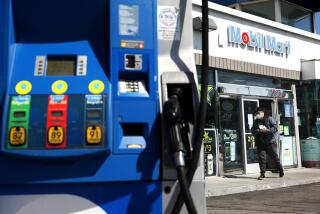Gas pumps also feeling the pinch
- Share via
REARDAN, WASH. — Men in Chip Colville’s family have been pumping gas here since his grandfather opened Colville’s Garage on Main Street in 1919.
Back then, cars shared the street with horses and mules in this farming town of 600 about 20 miles west of Spokane. A gallon of gasoline could be had for less than a quarter.
Now, Main Street is U.S. Highway 2 and a gallon of gas is edging toward $4. Diesel fuel passed the $4 mark in April.
And that’s the problem.
The three gasoline dispensers outside the Colville’s Inc. Chevron station were built when gasoline was less than $1 a gallon, and the mechanical meters on the pumps stop at $3.999.
Bob Renkes, executive vice president and general counsel of the Petroleum Equipment Institute of Tulsa, Okla., estimates that as many as 8,500 of the nation’s 170,000 service stations have the old meters, or about 17,000 individual dispensers that need to be fixed.
The mechanical meters have to be retrofitted with higher numbers whenever pump prices climb another dollar.
The last time it happened was in late 2005, when gasoline went over $3 a gallon, and owners of older pumps with mechanical computers had to install gear kits that went to $3.999.
Owners now need to replace another gear kit that goes to $4.999, and possibly higher.
“The last time when it wouldn’t go above $2.99, they came out with a retrofit kit. I think it cost about $40 per hose,” Colville said. “This time, there’s no kit available and I don’t think you’re even going to make one that is going to be compatible with these pumps.”
Al Eichorn, vice president of PMP Corp. of Avon Conn., which re-manufactures the mechanical computers, said Colville’s meters probably can be upgraded to a new model that reads up to $9.999, for a cost of about $600 to $650 per dispenser.
PMP has hired extra employees, who are working overtime, but still has a 14-week backlog of orders, Eichorn said.
“This happened in the ‘70s when gas went above $1,” Eichorn said. “The scary part then was we had a yearlong backlog. That’s the reason the states’ weights and measures people are allowing half-pricing.”
That’s the practice of selling fuel by the half gallon, then doubling the price shown on the meter for the total sale.
Colville and about a dozen other service station owners in Washington state have gotten variances for diesel fuel, which is above $4 a gallon.
They worry what will happen when the price of gasoline climbs above $4, forcing similar arrangements on all of their pumps.
“I posted the price prominently on the pump. I put a note that says, ‘Notice: The full price is twice this amount,’ ” Colville said.
He’s not sure he’ll be able to fix the meters on his pumps to allow sales by the gallon.
“These are older pumps, and there are not that many of them left. For them to put a lot of technology trying to figure out how to do them, the pump companies probably aren’t going to do it.”
Buying new pumps and dispensers with electronic computers is out of the question, he said.
“The new ones run between $10,000 and $15,000 apiece,” he said. “It’s an expense that’s not worth it.”
The old devices also top out at a $99.99 total sale price, meaning owners of SUVs, vans and trucks with larger tanks, as well as tractor-trailers, may be limited in the amount they can purchase at one time.
Jeff Lenard, spokesman for the National Assn. of Convenience Stores, a trade group that represents about 115,000 stores that sell gasoline, said some major credit card companies already place a $75 limit on the amount of gas that can be charged in a single fill-up.
Convenience stores sell about 80% of the gasoline pumped in this country, but those sales represent only about 33% of the stores’ profits, Lenard said.
The tiny margin on gasoline makes it less lucrative than other items the stores sell, he said.
“If gas is the profit driver and you are one of those guys with the old pumps, you’re either evolving or getting out,” he said. “If you’re just that kind of image of the ‘50s gas station where you have a conversation, fill up and have a cup of coffee, that’s in the movies.”
More to Read
Sign up for Essential California
The most important California stories and recommendations in your inbox every morning.
You may occasionally receive promotional content from the Los Angeles Times.













